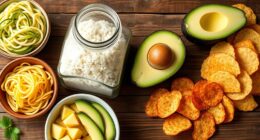To get started on the Keto diet, you'll need to cut carbs and boost your fat intake greatly. Aim for 70% fat, 20% protein, and only 10% carbohydrates. Focus on foods like fatty cuts of meat, full-fat dairy, and healthy oils while avoiding starchy vegetables and high-sugar fruits. Meal prepping can help you stay on track, making it easier to stick to those macronutrient ratios. As you shift, you might experience the "keto flu," so stay hydrated and manage your electrolytes to ease symptoms. If you want to explore more tips and benefits, there's plenty more to discover.
Key Takeaways
- Understand the macronutrient ratios: aim for 70% fat, 20% protein, and 10% carbohydrates to initiate ketosis.
- Include fatty meats, low-carb vegetables, and healthy oils while avoiding starchy foods and high-carb fruits.
- Plan meals ahead, focusing on high-fat ingredients and batch cooking for efficiency and convenience.
- Stay hydrated and maintain electrolyte levels to alleviate common side effects like fatigue and headaches.
- Gradually reintroduce carbs post-keto to avoid cravings and support long-term dietary sustainability.
Understanding the Keto Diet

The ketogenic diet, often referred to as keto, revolves around a simple yet powerful principle: drastically reducing your carbohydrate intake while increasing your fat consumption. This low carbohydrate diet typically consists of about 70% fat, 20% protein, and only 10% carbohydrates.
By limiting carbs to around 20 to 50 grams daily, you push your body into a metabolic state known as ketosis, where it starts burning fat for energy instead of carbohydrates. Incorporating nutrient-rich foods like celery juice can provide antioxidants beneficial for overall health.
In ketosis, your liver converts fats into ketones, providing an alternative energy source for your brain and other organs. Many people pursue the keto diet for its potential benefits, including significant weight loss and improved insulin levels, particularly for those managing conditions like type 2 diabetes.
However, you might experience some side effects during the initial phase, often referred to as the "keto flu." Symptoms like fatigue, headache, and nausea can occur as your body adjusts to these dietary changes.
It's crucial to incorporate healthy fats while maintaining your macros for the best results. Understanding these core principles will set you on the right path as you begin your keto journey.
Foods to Include and Avoid

When diving into the keto diet, knowing which foods to embrace and which to avoid is essential for successful weight loss and overall health. To kickstart your high-fat diet, focus on foods to include like fatty cuts of meat, full-fat dairy, and healthy oils such as olive and coconut oil. These will help you meet the 70-80% fat requirement that the keto diet promotes.
Additionally, maintaining proper hydration and being mindful of dietary choices can greatly influence your overall wellness during this shift, as evidenced by the importance of hydration in managing various health conditions, including gout symptoms.
Incorporate low-carb vegetables like leafy greens, cauliflower, and zucchini while staying clear of starchy options such as potatoes and corn. Limit your fruit intake to low-sugar options like avocados and berries, and avoid foods like bananas and grapes, which can spike your carb count.
Make protein sources like eggs, chicken, and fatty fish staples in your meals, but remember to moderate your intake since excess protein can convert to glucose and disrupt ketosis.
Meal Planning Strategies

Successfully steering through the keto diet requires more than just knowing what foods to include and avoid; effective meal planning can make a significant difference in your journey.
Start by familiarizing yourself with the macronutrient ratios of the ketogenic diet, aiming for about 70-80% fat, 15-25% protein, and less than 50 grams of carbohydrates daily. Incorporating healthy fats, such as those found in essential oils for hair growth, can also support overall wellness while following the keto lifestyle.
Craft a meal plan that highlights high-fat ingredients like avocados, nuts, and fatty cuts of meat while steering clear of starchy vegetables and sugars. To save time, batch cook large portions of keto-friendly recipes and keep low-carb snacks handy to curb cravings.
Utilizing a food diary or mobile app to track daily food intake will help you stay on top of your macronutrient goals and guarantee adherence to your keto plan.
Don't forget to incorporate a variety of low-carb vegetables and healthy fats to enhance your nutrient intake. This way, you can prevent potential deficiencies while enjoying the diverse flavors of the keto diet.
With well-structured meal planning, you'll feel more in control and empowered on your keto journey.
Managing Side Effects

As you start the keto diet, you might encounter some common side effects, often referred to as "keto flu."
These symptoms, like fatigue and headaches, can be uncomfortable but are typically temporary.
To ease the shift, it's important to stay hydrated and incorporate foods that support kidney health to help mitigate some of these effects.
Managing these effects is key, and we'll explore strategies to help you feel better during this shift.
Common Side Effects
What can you expect when starting the ketogenic diet? As your body shifts into ketosis, you might experience some common side effects known as the "keto flu." These can include fatigue, headache, nausea, irritability, and cramping, typically lasting about 3-4 days.
To manage these symptoms effectively, staying well-hydrated is essential. Make sure you're drinking plenty of water, and don't forget about your electrolytes—sodium, potassium, and magnesium can help alleviate headaches and cramping. It's important to also recognize how dietary changes can impact your overall financial health; just as budgeting is vital for managing expenses, planning your meals can help control costs associated with your new diet a budget plan for meals.
One helpful tip is to gradually reduce your carbohydrate intake instead of making an abrupt cut. This can ease your shift into ketosis, minimizing potential side effects.
While you adjust, focus on incorporating high-fat, low-carb foods like avocados, nuts, and coconut oil. These foods not only support your new diet but also provide the necessary energy your body needs.
Keep an eye out for signs of insufficient ketosis, such as persistent fatigue or strong cravings for carbs. Monitoring these signals can guide your dietary adjustments and help you stick to the ketogenic diet more effectively.
Managing Keto Flu Symptoms
Experiencing keto flu symptoms can be challenging, but there are effective ways to manage them. First, stay well-hydrated. Increasing your intake of electrolytes—especially sodium, potassium, and magnesium—can greatly alleviate symptoms since your body excretes more water and electrolytes during the shift to ketosis.
Additionally, maintaining good air quality in your environment can enhance your overall well-being as you adjust to the diet, making sure you breathe clean air while your body undergoes this change. For tips on improving indoor air, check out air purifier maintenance.
To minimize the severity of keto flu, gradually reduce your carbohydrate intake over several days instead of making a sudden change. This approach helps your body adapt more comfortably.
Focus on consuming adequate amounts of healthy fats and moderate protein, which will provide sustained energy and reduce feelings of fatigue and mental fog.
Additionally, confirm you're getting enough rest during this period. Engaging in light exercise can help boost your mood and energy levels, making it easier to cope with any irritability you might feel.
Benefits of the Keto Diet

The Keto Diet offers numerous benefits that can transform your health and well-being. One of the most notable advantages is weight loss; studies show participants often lose an average of 2 pounds more in the first few months compared to low-fat diets.
As you adopt the ketogenic diet, you may also experience improved blood sugar control, with about 60% of type 2 diabetes patients reversing their condition after making the switch. Additionally, the Keto Diet has the potential to enhance your investment strategies, as individuals may find themselves more focused and disciplined, similar to how one should approach IRA rollover to gold.
Many people report enhanced mental clarity and energy levels. This occurs because your brain efficiently uses ketones produced from fat metabolism, leading to improved cognitive function and sustained energy throughout the day.
The diet can also positively impact your cholesterol levels, reducing triglycerides while increasing HDL cholesterol.
Beyond these everyday benefits, the Keto Diet has therapeutic potential, such as reducing seizure frequency in drug-resistant epilepsy patients.
Long-term Considerations

Maintaining a ketogenic diet long-term can be quite a challenge for many people. To guarantee you're on the right track, consider these key factors:
- Reintroducing Carbohydrates: Gradually add carbs back into your diet to prevent metabolic shock and cravings. This aligns with the importance of emotional resilience as you navigate changes in your nutrition.
- Regular Health Check-ups: Schedule check-ups to monitor for potential nutrient deficiencies that may arise from a limited food variety.
- Dietary Flexibility: Incorporate periodic low-carb days to enhance your dietary options and help maintain long-term weight loss without feeling deprived.
- Continuous Education: Stay informed about nutrition and lifestyle adjustments to support a healthy weight post-keto. Engaging in this learning process can be akin to the transformative possibilities revealed by imagination.
Many struggle with weight regain after the initial phase, so maintaining a balance is essential.
Embracing flexibility in your diet won't only help you stick with your goals but also promote a sustainable lifestyle.
Remember, the journey doesn't end when you exit the keto phase. Continuous learning and adapting are significant for achieving lasting success and maintaining a healthy weight.
Frequently Asked Questions
How Do I Start My Keto Diet for the First Time?
To start your keto diet, calculate your daily caloric needs, limit carbs to 20-50 grams, focus on healthy fats, meal prep, and prepare for initial side effects. Utilize resources to track your progress. Some additional keto diet tips to consider are to make sure you stay hydrated by drinking plenty of water, incorporate a variety of low-carb vegetables into your meals, and listen to your body to make adjustments as needed. It’s also beneficial to educate yourself on the different food options that align with the keto diet, and to seek support from online communities or professionals to stay motivated and accountable in your journey. By following these keto diet tips, you can set yourself up for success in reaching your health and wellness goals.
How Do Beginners Get Into Ketosis?
To get into ketosis, you need to drastically cut carbs to 20-50 grams daily, consume healthy fats for 70-80% of your calories, and monitor your protein intake. Stay hydrated and track your food intake.
How Does the Keto Diet Work for Beginners?
The keto diet works by drastically lowering your carb intake, forcing your body into ketosis. In this state, your liver converts fats into ketones, providing energy and enhancing mental clarity as you adapt to burning fat.
What Are the Basic Rules for Keto?
Isn't it fascinating how simple rules can transform your health? To succeed on keto, you'll need to limit carbs to 20-50 grams daily, focus on high fats, and stay hydrated while monitoring your progress.
Conclusion
Starting the keto diet can feel like setting sail on a new adventure. Just like a ship needs the right wind to navigate, your body needs the right fuel to thrive. Remember that while you might face some choppy waters initially, the benefits of clearer energy and weight loss can be your lighthouse guiding you home. Stay committed, plan your meals, and embrace the journey—soon, you'll find smooth sailing ahead on your keto path!









